Photosynthesis can be divided into two stages:
- Light Reactions : Light energy (absorbed from the sun) is converted to chemical energy, which is temporarily stored in ATP and the energy carrier molecule NADPH.
- Dark Reaction/Calvin Cycle : Organic compounds are formed using CO2 and the chemical energy stored in ATP and NADPH.
The Light Reactions occur in the grana and the Dark Reactions take place in the stroma of the chloroplasts.
Chloroplast
The first stage of photosynthesis includes the light reactions, so named because they require light to happen. The light reactions begin with the absorption of light in chloroplasts, organelles found in the cells of plants and algae. Most chloroplasts are similar in structure. Each chloroplast is surrounded by a pair of membranes. Inside the inner membrane is another system of membranes called thylakoids that are arranged as flattened sacs. The thylakoids are connected and layered to form stacks called grana (singular, granum).Surrounding the grana is a solution called the stroma. The photosynthetic pigments in chloroplasts are located in the thylakoid membranes. The primary light absorbing pigments in higher plants are the chlorophylls.
Light Reactions
In the Light Dependent Processes (Light Reactions) light strikes chlorophyll a in such a way as to excite electrons to a higher energystate. In a series of reactions the energy is converted (along an electron transport process) into ATP and NADPH. Water is split in the process, releasing oxygen as a by-product of the reaction. The ATP and NADPH are used to make C-C bonds in the Light Independent Process (Dark Reactions).
Photosystems are arrangements of chlorophyll and other pigments packed into thylakoids. Many Prokaryotes have only one photosystem, Photosystem II (so numbered because, while it was most likely the first to evolve, it was the second one discovered). Eukaryotes have Photosystem II plus Photosystem I. Photosystem I uses chlorophyll a, in the form referred to as P700. Photosystem II uses a form of chlorophyll a known as P680. Both “active” forms of chlorophyll a function in photosynthesis due to their association with proteins in the thylakoid membrane.
Photophosphorylation is the process of converting energy from a light-excited electron into the pyrophosphate bond of an ADP molecule. This occurs when the electrons from water are excited by the light in the presence of P680. The energy transfer is similar to the chemiosmotic electron transport occurring in the mitochondria. Light energy causes the removal of an electron from a molecule of P680 that is part of Photosystem II. The P680 requires an electron, which is taken from a water molecule, breaking the water into H+ ions and O-2ions. These O-2 ions combine to form the diatomic O2 that is released. The electron is “boosted” to a higher energy state and attached to a primary electron acceptor, which begins a series of redox reactions, passing the electron through a series of electron carriers, eventually attaching it to a molecule in Photosystem I. Light acts on a molecule of P700 in Photosystem I, causing an electron to be “boosted” to a still higher potential. The electron is attached to a different primary electron acceptor (that is a different molecule from the one associated with Photosystem II).
The electron is passed again through a series of redox reactions, eventually being attached to NADP+ and H+ to form NADPH, an energy carrier needed in the Light Independent Reaction. The electron from Photosystem II replaces the excited electron in the P700 molecule. There is thus a continuous flow of electrons from water to NADPH. This energy is used in Carbon Fixation. Cyclic Electron Flow occurs in some eukaryotes and primitive photosynthetic bacteria. No NADPH is produced, only ATP. This occurs when cells may require additional ATP, or when there is no NADP+ to reduce to NADPH. In Photosystem II, the pumping to H ions into the thylakoid and the conversion of ADP + P into ATP is driven by electron gradients established in the thylakoid membrane.
Dark Reactions
The Calvin cycle is a series of enzyme-assisted chemical reactions that produces a three-carbon sugar. In the Calvin cycle, carbon atoms from CO2 in the atmosphere are bonded, or “fixed,” into organic compounds. This incorporation of CO2 into organic compounds is called carbon fixation. A total of three CO2 molecules must enter the Calvin cycle to produce each three-carbon sugar that will be used to make the organic compounds. The Calvin cycle occurs within the stroma of the chloroplast. Figure below shows the events that occur when three CO2 molecules enter the Calvin cycle.
- CO2 diffuses into the stroma from the surrounding cytosol. An enzyme combines each CO2 molecule with a five-carbon molecule called ribulose bisphosphate (RuBP). The six-carbon molecules that result are very unstable, and they each immediately split into two three-carbon molecules. These three-carbon molecules are called 3-phosphoglycerate (3-PGA).
- Each molecule of 3-PGA is converted into another three-carbon molecule, glyceraldehyde 3-phosphate (G3P), in a two-part process. First, each 3-PGA molecule receives a phosphate group from a molecule of ATP. The resulting compound then receives a proton (H+) from NADPH and releases a phosphate group, producing G3P. The ADP, NADP+, and phosphate that are also produced can be used again in the light reactions to make more ATP and NADPH.
- One of the G3P molecules leaves the Calvin cycle and is used to make organic compounds (carbohydrates) in which energy is stored for later use.
- The remaining G3P molecules are converted back into RuBP through the addition of phosphate groups from ATP molecules. The resulting RuBP molecules then enter the Calvin cycle again.
The Calvin cycle (named for Melvin Calvin, the American biochemist who worked out the chemical reactions in the cycle) is the most common pathway for carbon fixation. Plant species that fix carbon exclusively through the Calvin cycle are known as C3 plants because of the three-carbon compound that is initially formed in this process.
The C4 & CAM Pathway
Many plant species that evolved in hot, dry climates fix carbon through alternative pathways. Under hot and dry conditions, plants can rapidly lose water to the air through small pores called stomata. Stomata (singular, stoma), are usually located on the undersurface of the leaves. Plants can reduce water loss by partially closing their stomata when the air is hot and dry. Stomata are the major passageways through which CO2 enters and O2 leaves a plant. When a plant’s stomata are partly closed, the level of CO2 in the plant falls as CO2 is consumed in the Calvin cycle. At the same time, the level of O2 in the plant rises as the light reactions generate O2. Both a low CO2 level and a high O2 level inhibit carbon fixation by the Calvin cycle. Alternative pathways for carbon fixation help plants deal with this problem.
The C4 Pathway
One alternative pathway enables certain plants to fix CO2 into four-carbon compounds. This pathway is thus called the C4 pathway, and plants that use it are known as C4 plants. During the hottest part of the day, C4 plants have their stomata partially closed. However, certain cells in C4 plants have an enzyme that can fix CO2 into four-carbon compounds even when the CO2 level is low and the O2 level is high. These compounds are then transported to other cells, where CO2 is released and enters the Calvin cycle. C4 plants include corn, sugar cane, and crab grass. Such plants lose only about half as much water as C3 plants when producing the same amount of carbohydrates. Many plants that use the C4 pathway evolved in tropical climates.
The CAM Pathway
Cactuses, pineapples, and certain other plants have a different adaptation to hot, dry climates. Such plants fix carbon through a pathway called the CAM pathway. CAM is an abbreviation for crassulacean acid metabolism, because this water-conserving pathway was first discovered in plants of the family Crassulaceae, such as the jade plant. Plants that use the CAM pathway open their stomata at night and close them during the day—just the opposite of what other plants do. At night, CAM plants take in CO2 and fix it into a variety of organic compounds. During the day, CO2 is released from these compounds and enters the Calvin cycle. Because CAM plants have their stomata open at night, when the temperature is lower, they grow fairly slowly. However, they lose less water than either C or C plants.
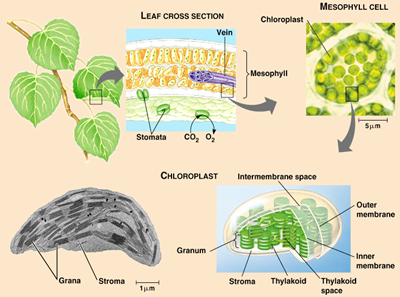
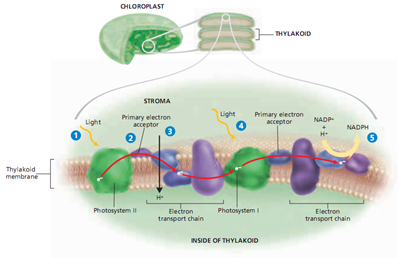
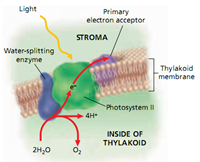
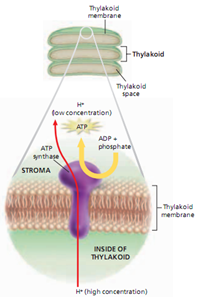
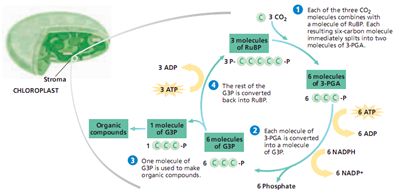






0 comments :
Post a Comment